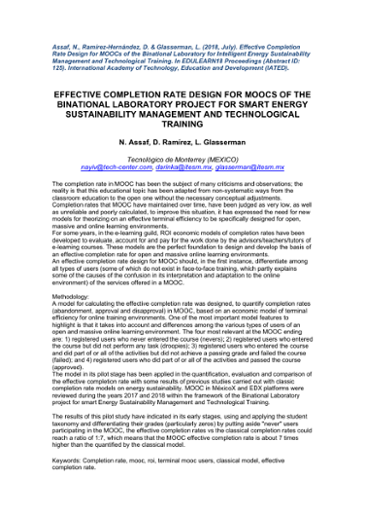| dc.contributor.author | Assaf, Nayiv | |
| dc.contributor.author | Ramírez-Hernández, Darinka | |
| dc.contributor.author | Glasserman, Leonardo | |
| dc.date.accessioned | 2018-06-08T13:55:13Z | |
| dc.date.available | 2018-06-08T13:55:13Z | |
| dc.date.issued | 2018-07-04 | |
| dc.identifier.uri | http://hdl.handle.net/11285/630107 | |
| dc.description.abstract | The completion rate in MOOC has been the subject of many criticisms and observations; the reality is that this educational topic has been adapted from non-systematic ways from the classroom education to the open one without the necessary conceptual adjustments. Completion rates that MOOC have maintained over time, have been judged as very low, as well as unreliable and poorly calculated, to improve this situation, it has expressed the need for new models for theorizing on an effective terminal efficiency to be specifically designed for open, massive and online learning environments. For some years, in the e-learning guild, ROI economic models of completion rates have been developed to evaluate, account for and pay for the work done by the advisors/teachers/tutors of e-learning courses. These models are the perfect foundation to design and develop the basis of an effective completion rate for open and massive online learning environments. An effective completion rate design for MOOC should, in the first instance, differentiate among all types of users (some of which do not exist in face-to-face training, which partly explains some of the causes of the confusion in its interpretation and adaptation to the online environment) of the services offered in a MOOC. | |
| dc.format | Abstract / Abstract | en_US |
| dc.language.iso | eng | en_US |
| dc.relation | 266632-CONACYT-SENER-S0019201401 | en_US |
| dc.relation.url | https://iated.org/edulearn/ | en_US |
| dc.rights | Open Access | en_US |
| dc.rights.uri | http://creativecommons.org/licenses/by-nc-nd/3.0/us/ | * |
| dc.title | Effective Completion Rate Design for MOOCs of the Binational Laboratory for Intelligent Energy Sustainability Management and Technological Training | en_US |
| dc.type | Artículo de Conferencia / Conference Article | en_US |
| dc.conference.name | EDULEARN18 Proceedings | en_US |
| dc.conference.host | IATED Academy | en_US |
| dc.conference.location | Palma de Mallorca, España | en_US |
| dc.subject.keyword | Completion rate | en_US |
| dc.subject.keyword | MOOC | en_US |
| dc.subject.keyword | ROI | en_US |
| dc.subject.keyword | Terminal mooc users | en_US |
| dc.subject.keyword | Classical model | en_US |
| dc.subject.keyword | Effective completion rate | en_US |
| dc.contributor.affiliation | Tecnologico de Monterrey | en_US |
| dc.subject.discipline | Ciencias Sociales / Social Sciences | en_US |
| refterms.dateFOA | 2018-06-08T13:55:14Z | |
| html.description.abstract | <html>
<head>
<title></title>
</head>
<body>
<p>The completion rate in MOOC has been the subject of many criticisms and observations; the reality is that this educational topic has been adapted from non-systematic ways from the classroom education to the open one without the necessary conceptual adjustments.</p>
<p><br />
Completion rates that MOOC have maintained over time, have been judged as very low, as well as unreliable and poorly calculated, to improve this situation, it has expressed the need for new models for theorizing on an effective terminal efficiency to be specifically designed for open, massive and online learning environments.</p>
<p><br />
For some years, in the e-learning guild, ROI economic models of completion rates have been developed to evaluate, account for and pay for the work done by the advisors/teachers/tutors of e-learning courses. These models are the perfect foundation to design and develop the basis of an effective completion rate for open and massive online learning environments.</p>
<p><br />
An effective completion rate design for MOOC should, in the first instance, differentiate among all types of users (some of which do not exist in face-to-face training, which partly explains some of the causes of the confusion in its interpretation and adaptation to the online environment) of the services offered in a MOOC.</p>
</body>
</html> | en_US |

